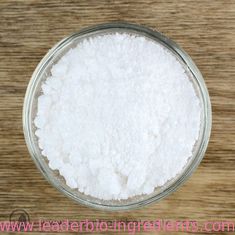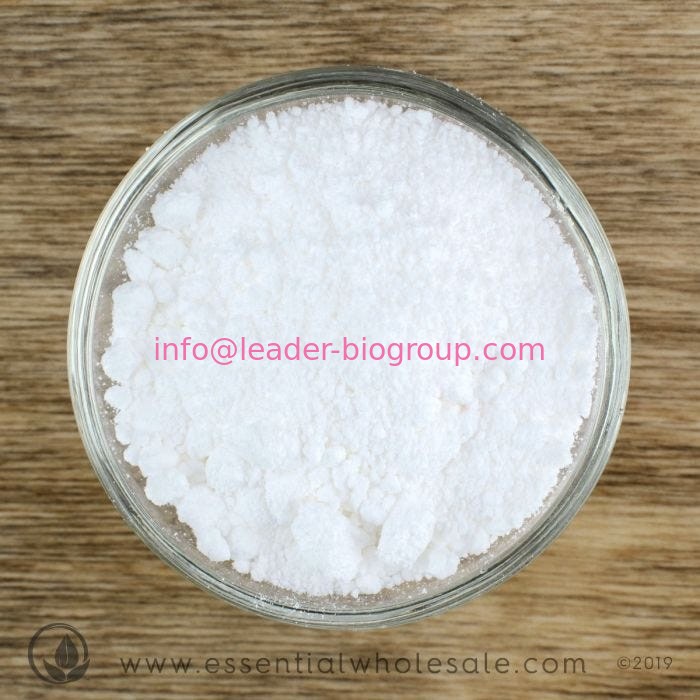
China Northwest Factory Manufacturer 5-HTP/5-hydroxytryptophane Cas 56-69-9 For stock delivery
-
Purity99.9%
-
UseHealth Care
-
OriginChina
-
Package1KG/Tin 25KG/Drum*Carton
-
ManufacturerXI'AN LEADER BIOCHEMICAL ENGINEERING CO.,LTD
-
Place of OriginCHINA
-
Brand NameLeader
-
CertificationISO,GMP,SGS,HALA,KOSER,HACCP
-
Model NumberLD
-
Minimum Order Quantity25KGS
-
PriceNegotiate
-
Packaging Details25KG/Drum
-
Delivery Time2-3 working days
-
Payment TermsWestern Union, MoneyGram, T/T, L/C
-
Supply Ability10MTS/Month
China Northwest Factory Manufacturer 5-HTP/5-hydroxytryptophane Cas 56-69-9 For stock delivery
| 5-Hydroxytryptophan Basic information |
| Product Name: | 5-Hydroxytryptophan |
| Synonyms: | DL-5-HTP;DL-5-HYDROXYTRYPTOPHAN;DL-2-AMINO-3-(5-HYDROXYINDOLYL)PROPIONIC ACID;HYDROXYTRYPTOPHAN;5-HYDROXY-DL-TRYPTOPHAN;5-Hydroxytryptophan(5-HTP);DL-2-Amino-3-(5-hydroxyindolyl)propionic acid, DL-5-HTP;5-HTP (Griffonia Seeds P.E.) |
| CAS: | 56-69-9 |
| MF: | C11H12N2O3 |
| MW: | 220.22 |
| EINECS: | 200-284-8 |
| Product Categories: | Inhibitors;Plant extracts;Herb extract;chemical reagent;pharmaceutical intermediate;phytochemical;Standard extract;Amines;Heterocycles;Intermediates & Fine Chemicals;Metabolites & Impurities;Pharmaceuticals;reference standards from Chinese medicinal herbs (TCM).;standardized herbal extract |
| Mol File: | 56-69-9.mol |
| 5-Hydroxytryptophan Chemical Properties |
| Melting point | 298-300°C |
| Boiling point | 361.16°C (rough estimate) |
| density | 1.484 |
| refractive index | 1.5200 (estimate) |
| storage temp. | 2-8°C |
| pka | 2.22±0.10(Predicted) |
| form | solid |
| Water Solubility | Soluble in water (4 mg/ml at 25°C), methanol. |
| Merck | 14,4847 |
| BRN | 88199 |
| InChIKey | LDCYZAJDBXYCGN-UHFFFAOYSA-N |
| CAS DataBase Reference | 56-69-9(CAS DataBase Reference) |
| EPA Substance Registry System | Tryptophan, 5-hydroxy- (56-69-9) |
| Safety Information |
| Safety Statements | 26 |
| WGK Germany | 3 |
| RTECS | YN7100000 |
| PackingGroup | III |
| Hazardous Substances Data | 56-69-9(Hazardous Substances Data) |
| MSDS Information |
| Provider | Language |
|---|---|
| DL-2-Amino-3-(5-hydroxyindolyl)propionic acid | English |
| ACROS | English |
| ALFA | English |
| 5-Hydroxytryptophan Usage And Synthesis |
| Chemical Properties | Off-White to Pale Beige Solid |
| Originator | Levotonine,Panmedica,France,1973 |
| Uses | A metabolite of Tryptophan |
| Manufacturing Process | Preparation of 4-benzyloxyphenylhydrazine: 200 grams 4-benzyloxyaniline hydrochloride was suspended in a mixture of 264 ml concentrated hydrochloric acid, 528 ml water and 732 grams crushed ice. A solution of 62.4 grams sodium nitrite in 136 ml water was added below the surface of the stirred suspension at -10-(+/-)2°C during 10 minutes. After stirring for 1 hour at 0°C, the suspension was treated with acid-washed charcoal and filtered. The filtrate was cooled and maintained at -8°C while a solution of 500 grams of stannous chloride in 760 ml concentrated hydrochloric acid was added with stirring. The mixture was stirred for 2 hours at -8°C and the 4- benzyloxyphenylhydrazine hydrochloride which separated was filtered off and washed with water. The product was crystallized by adding 800 ml hot water to a 3 liter solution in ethanol and had a MP of 185° to 189°C (yield 168.5 grams, 79%). Preparation of Ethyl α-Acetylamino-α-Carbethoxy-β-(5-Benryloxy-Indolyl-3)- Propionate: 4-benzyloxyphenylhydrazine hydrochloride was converted to the corresponding base 2 to 3 hours before use: 28 grams of the hydrochloride was suspended in 500 ml chloroform and shaken with 55 ml 2N sodium hydroxide in 100 ml water. The chloroform was separated and the aqueous phase reextracted with chloroform (2 x 100 ml). After washing with 100 ml water, the chloroform solution was dried over sodium sulfate, filtered and evaporated at 30° to 35°C, leaving 4-benzyloxyphenylhydrazine as a friable buff-colored solid (23 grams, 97% from hydrochloride). 6.1 grams freshly distilled acrylic aldehyde (acrolein) in 9.7 ml chlorobenzene was added at 30°C over 30 minutes to a stirred suspension of 24.2 grams diethyl acetylaminomalonate in 37.5 ml chlorobenzene containing a catalytic amount (0.25 ml) of 50% w/v aqueous sodium hydroxide. After a further 30 minutes the resultant solution was warmed and 23 grams 4- benzyloxyphenylhydrazine was added at 45°C. The mixture was stirred and heated at 65° to 70°C for 1 hour to complete condensation, when a red solution was formed. The resultant chlorobenzene solution was added to 440 ml N sulfuric acid and the suspension was refluxed with stirring for 6 hours. The product was extracted with chloroform (250 + 100 ml), and the chloroform solution washed with water (3 x 100 ml), separated and dried over sodium sulfate. After filtration and concentration at 40°C to 100 ml, 300 ml light petroleum (BP 40° to 60°C) was added to the warm chloroform-chlorobenzene solution. 33.1 grams ethyl α-acetylamino-α-carbethoxy-β-(5-benzyloxyindolyl-3)- propionate crystallized on cooling from the mixture. It was recrystallized by dissolving in 200 ml benzene and adding 100 ml light petroleum (BP 60° to 80°C) at the boiling point. After cooling, the buff crystals were collected, washed with cold benzene/light petroleum (1:1) mixture (50 ml), and dried at 55°C (yield 26.0 grams, 54%, MP 164° to 165°C). Preparation of α-Acetylamino-α-Carboxy-β-(5-Benzyloxy-Indolyl-3)-Propionic Acid: 18 grams ethyl α-acetylamino-α-carbethoxy-β-(5-benzyloxy-indolyl-3)-propionate was suspended in 85 ml water containing 8.5 grams sodium charcoal. The suspension was refluxed for 4 hours, decolorizing charcoal added, and the solution filtered hot through Hyflo Supercel. After cooling in ice to 10°C, the solution was acidified with 24 ml concentrated hydrochloric acid. The solid which separated was filtered off, washed with water (3 x 30 ml) and dried in vacuo over silica gel, to give α-acetylamino-α- carboxy-(5-benzyloxy-indolyl-3)-propionic acid, MP 144° to 146°C (15.0 grams, 95%) sufficiently pure for use in the next stage. Preparation of α-Acetylamino-β-(5-Benzyloxy-Indolyl-3)-Propionic Acid: 15 grams α-acetylamino-α-carboxy-β-(5-benzyloxy-indolyl-3)-propionic acid was suspended in 225 ml water and the suspension refluxed and stirred in a stream of nitrogen until evolution of carbon dioxide ceased (about 2 hours). After cooling somewhat, 120 ml ethyl alcohol was added and the suspension refluxed until the product dissolved. Charcoal was added to the solutior the mixture filtered hot, and the filter-cake washed with 50 ml hot 50% aqueous ethanol. α-Acetylamino-β-(5-benzyloxy-indolyl-3)-propionic acid, MP 164° to 166°C, which crystallized from the filtrate on cooling, was collected, washed with an ice-cold mixture of 15 ml ethanol and 45 ml water, and dried in vacuo over silica gel (yield 11.1 grams, 83%). Preparation of 5-Benzyloxytryptophan: 11 grams α-acetylamino-β-(5- benzyloxy-indolyl-3)-propionic acid was suspended in a solution of 12 grams sodium hydroxide in 90 ml water and refluxed for 24 hours. Charcoal was added to the resultant solution and the mixture filtered hot. 150 ml 2N hydrochloric acid was added to the filtrate at 70°C and 5-benzyloxytryptophan crystallized on cooling. After washing with water and drying in vacuo over silica gel, the amino acid (6.9 grams, 71%) had MP (sealed evacuated tube) 232°C, with softening, finally melting at 237° to 238°C (decomposition). Charcoal was added to the filtrate, which was filtered hot and adjusted to pH 2. On cooling a second crop of 5-benzyloxytryptophan was obtained (2.2 grams, 23%), MP (sealed evacuated tube) 230°C, with softening, finally melting at 233° to 237°C (decomposition). The overall yield of 5- benzyloxytryptophan was 9.1 grams (94%). Preparation of 5-Hydroxytryptophan: 0.4 gram palladium chloride and 1.7 grams acid-washed charcoal were suspended in 157 ml water and hydrogenated at room temperature and atmospheric pressure until no further hydrogen uptake occurred. A suspension of 14.2 grams 5- benzyloxytryptophan in 175 ml ethyl alcohol was added and the mixture hydrogenated under similar conditions. A hydrogen uptake slightly in excess of theory was obtained. The suspension was warmed for a few minutes on the steam bath and filtered hot. The filter-cake was washed with hot water (3 x 20 ml) and the filtrate evaporated to 20 ml under reduced pressure in a nitrogen atmosphere. The resultant mass of colorless crystals was triturated with 250 ml ice-cold ethyl alcohol under hydrogen, filtered, and washed with cold ethyl alcohol (2 x 15 ml). The 5-hydroxytryptophan (6.9 grams, 69%) had MP (sealed evacuated tube) 288°C, with softening, finally melting at 249° to 247°C (decomposition). Concentration of the liquors under reduced pressure in a nitrogen atmosphere, and trituration as before, gave a second crop (0.9 gram, 9%). The combined crops (7.8 grams) were dissolved in 120 ml hot water, charcoal added, and the mixture filtered hot. The filtrate was concentrated in a nitrogen atmosphere under reduced pressure and ethyl alcohol added. The 5-hydroxytryptophan then crystallized as colorless microneedles (6.5 grams,65%), had MP (sealed evacuated tube) 290°C, with slight softening, finally melting at 295° to 297°C (decomposition). |
